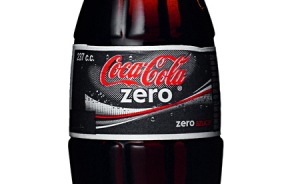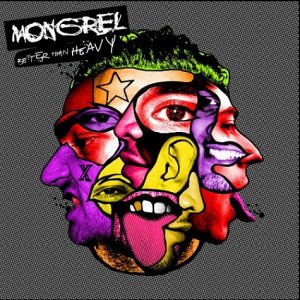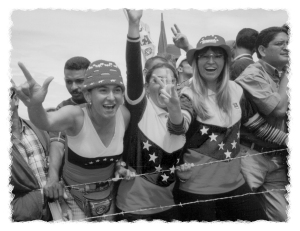Disney’s animated movie “Up!”, featuring the striking landscapes of southeastern Venezuela, has opened in many theaters around the U.S. In an interview to the Associated Press, the film’s director and story supervisor discussed the trip they took to Angel Falls and the tepuis (a table-top mountain) of Venezuela and Brazil during the making of the film. They described it as “the most magnificent trip that most of us would take in our lifetime” and called on tourists to be “respectful of the locations” and not “ruin them ’cause they are really beautiful places.” Watch the trailer featuring Angel Falls below.
Archive for the ‘Arts & Culture’ Category
Venezuela’s Angel Falls Stage for New Disney Movie
Posted in Arts & Culture, Nature & Environment on June 19, 2009| Leave a Comment »
Zero of ‘Coke Zero’ in Venezuelan Stores
Posted in Arts & Culture on June 11, 2009| Leave a Comment »
 Well, looks like Venezuela has done what many consumer advocacy groups and medical experts have been hoping the US would do for some time.
Well, looks like Venezuela has done what many consumer advocacy groups and medical experts have been hoping the US would do for some time.
One of the many diet soft drinks known to contain potentially carcinogenic ingredients like aspartame and acesulfame potassium has been taken off of Venezuelan store shelves and will no longer be available for purchase. It’s a start health experts say.
Yesterday, the Venezuelan Health Ministry made the announcement that “Coke Zero” would not be sold while health authorities investigate its ingredients for potentially unsafe substances.
Venezuela Unveils Low-Cost, Locally-Made Phones
Posted in Arts & Culture, Society & Politics, tagged cell phone, Chavez, China, economy, gadgets, latin america, news, politics, tech, Technology, telecommunications, venezuela, vergatario on May 11, 2009| Leave a Comment »


Venezuelans can now buy cell phones for the equivalent of just US $13.95, thanks to a new state-run company that put its first 5,000 units on the market yesterday in Caracas.
Eager shoppers snapped up the first bunch, and the AP reports that another 5,000 will be in stores soon.
The tiny phone, dubbed “El Vergatario,” is equipped with a camera, radio, and mp3 player.
The firm that makes them, a joint venture by the governments of Venezuela and China, is known as Vetelca. This is not an isolated effort, but rather, part of a broader plan to promote affordable technology (you may recall the “Bolivarian Computer,” and the adoption of open-source Linux operating systems).
“El Vergatario” is only sold on the domestic market right now, but depending on its success, it could eventually become an export. And because it is literally the cheapest cell phone in the world, it is likely to be quite competitive.
Better than Free – British Music in Venezuela
Posted in Arts & Culture, tagged Alo Presidente, Arctic Monkeys, Babyshambles, Better than Heavy, Britain, British music, caracas, culture, Damian Marley, free music, Hugo Chavez, Jamaica, Mongrel, music, Poisonous Poets, reggae, Reverend and the Makers, United Kindgdom, venezuela, venezuelan music on April 16, 2009| Leave a Comment »

According to Billboard Music, the band Mongrel is “genre smashing”. The supergroup promotes peace and political consciousness in their lyrics.
Comprised of members from several bands, including Reverend & the Makers, Poisonous Poets, Arctic Monkeys, and Babyshambles, Mongrel is set to put some Venezuelan flavor in their tunes.
This month they’ll travel to Venezuela to launch a musical program and give a free show.
Mongrel is dedicated to sharing music and will give away thousands of CDs when they arrive in Caracas later this month. 400,000 copies of their last album “Better than Heavy” were distributed for free throughout Britain.
They’ll also make an appearance on the President Chavez’s weekly television show Aló Presidente. Plans are in the works to do a new album based on Jamaican reggae and Venezuela folk music, hopefully featuring Damian Marley.
Watch this video of their song “The Menace”.
Venezuela Participates in NY Indigenous Film Fest
Posted in Arts & Culture, tagged brazil, cinema, conservation, David Hernández-Palmar, documentary, entertainment, environment, film, film festival, Indigenous, indigenous communities in venezuela, Owners of the water, rio das mortes, venezuela, water, Wayuu, xavante on March 26, 2009| Leave a Comment »
 David Hernández-Palmar, a young Venezuelan man from the Wayuu Indigenous community, will be in New York City this Saturday to help present a documentary at the 30th Annual Native American Film and Video Festival.
David Hernández-Palmar, a young Venezuelan man from the Wayuu Indigenous community, will be in New York City this Saturday to help present a documentary at the 30th Annual Native American Film and Video Festival.
“Owners of the Water: Conflict and Collaboration over Rivers” was created by Hernández-Palmar together with Caimi Waiassé (a Brazilian Xavante man) and U.S. Anthropologist Laura R. Graham. It chronicles an international campaign to protect Rio das Mortes River Basin in Brazil, a vital resource for the Xavante community that was threatened by soya production and related deforestation. The Xavante blocked a national highway to demand the protection of the basin.
To help tell the story of the Xavante’s struggle, Venezuela’s David Hernández-Palmar lent his talents as an up-and-coming documentarian. For more information about this and other films at the Native American Film and Video Festival, click here.
Film Shows Struggle for Progress in Venezuela’s “Colonia Tovar”
Posted in Arts & Culture, tagged Agostino Codazzi, caracas, Colonia Tovar, culture, documentaries, entertainment, George Walker Torres, Maria and the new world, Maria y el nuevo mundo, movies, news, tourism, Travel, venezuela, venezuelan directors, Venezuelan film, Venezuelan movies on March 16, 2009| Leave a Comment »

Debuting soon is a new documentary about Colonia Tovar, the German settlement that lies just 60 kilometers outside of Caracas, but is culturally much further removed. The community, a small but well-touristed village of perhaps 6,000 people, was founded in 1840 by the intrepid Italian geographer Agostino Codazzi.
Colonia Tovar provides the setting for “María y el nuevo mundo” (Maria and the New World), the first full-length film from Venezuelan director George Walker Torres. It tells the story of a middle-aged woman who struggles to survive on a garbage dump and dreams of being reunited with her daughter. A parallel is drawn between her search to create a better life and that of the initial founders of the town.
The documentary is promoted by Venezuela’s National Film Board, or Centro Nacional Autónomo de Cinematografía (CNAC). Read more in Spanish. Check back here to watch the trailer once it’s available.
Venezuelan Woman Promotes Intercultural Education
Posted in Arts & Culture, Society & Politics, tagged Afro-Venezuelans, Angela Diaz, Art, caribbean, culture, curricula, Donald Payne, education, education in venezuela, food, History, Howard University, Indigenous, Latin American history, news, politics, schools in venezuela, South America, TransAfrica Forum, venezuela, Venezuelan History, venezuelan women, Washington, women, youth on March 13, 2009| 1 Comment »

Intercultural education will soon become a reality in Venezuela, if Professor Angela Diaz has anything to do with it.
She spoke at at a public event today in Washington sponsored by TransAfrica Forum. Diaz has been making her way around the U.S. capital, speaking at Howard University and meeting Members of Congress to discuss the Afro-Venezuelan experience.
Diaz is a member of the Network of Afro-Venezuelan Organizations (La Red de Organizaciones Afrovenezolanas), has worked tirelessly over the past decade to help create a more inclusive education system. Like the U.S., Afro-descendants and Indigenous peoples in Venezuela have been too often distorted or omitted from public school curricula. Due to the work of people like Diaz, Venezuelan students will learn about all the ethnic groups that built the South American continent.
The new inclusive curriculum has been implemented in 17 states so far. Part of the process involves inviting community elders into the schools to teach. In one school, grandparents taught students how to make a fish recipe, which is stuffed in a plantain leaf. Fish is a vital resource for residents along the Caribbean coast, many of whom identify as Afro-Venezuelan. Along with the recipe, the children learned about history, culture, art, and the environment. Sharing ancestral knowledge is the key to transmitting what has been left out of the history books.
Diaz emphasized that students are inspired when they can see themselves and their communities represented in their lessons. See more of Professor Diaz’s work with Fundación Curduvare.
Salsa Caraqueña at “El Maní” – Worth the Price of the Flight
Posted in Arts & Culture, tagged caracas, Caracas Metro, Caracas nightlife, dance, El Cantante, El Mani, El Mani es Asi, entertainment, Hector Lavoe, latin america, music, rum, Sabana Grande, Salsa, salsa dancing, Travel, venezuela, Venezuelan culture, Venezuelan dance, venezuelan music on March 3, 2009| Leave a Comment »
.jpg)
No visit to Venezuela is complete without a visit to Caracas, and no visit to Caracas is complete without Saturday night at El Maní es Así, a veritable institution of Latin American salsa.
Called El Maní (the peanut) for short, it is simply one of the greatest salsa clubs on planet earth. Located in the heart of Caracas in Sabana Grande, nearly every taxi driver can take you there. It’s Metro accessible, but you’ll need to take a cab back, since the Metro shuts down before the party does.
Admission to El Maní is usually free, and the crowd is diverse and friendly. Get there early to nab a table. The caraqueño nightlife custom is to purchase a bottle of liquor (with mixers) or mini keg of beer to reserve your table for the night. The waitstaff is attentive and quick, so tip well! The place is full by 9 pm, but the dance floor always has room for another couple.
Top Latin American salsa bands perform there every weekend, and even party goers without skills will be tempted (and invited!) to dance. Don’t worry — someone will offer to teach you the steps. The rhythm is hard to fight, the rum is superb, and the house lights will come on before you know it.
El Maní is a great place to see the real Caracas, and a wonderful place to fall in love — with Venezuela, of course!
Check out this great photo montage of the club with music by salsa legend “la voz” Héctor Lavoe.
Arepa Update: A Treat You Can Take Anywhere
Posted in Arts & Culture, The Region, tagged arepa, Boston, caracas, culture, entertainment, food, latin america, Los Angeles, Miami, New York, Travel, venezuela, Venezuelan cuisine, Venezuelan culture, Venezuelan food, venezuelan traditions on February 26, 2009| 2 Comments »

The arepa is truly a food without borders. Though it is emblematic of Venezuela, the savory cornmeal snack has a presence abroad, too! Here are some suggestions for where to find arepas in the U.S.:
In New York, the Caracas Arepa Bar (pictured above) is located on 7th St. the East Village. Here, rumor has it you are nearly required to to try Venezuelan-style guacamole, called guasacaca. Rivals El Cocotero are over on West 18th St.
Lucky for folks in Boston, the up-and-coming Orinoco has two locations, one in the South End and another in Brookline. They have a nice date-worthy ambiance and also sell t-shirts with funny slogans like “arepa boy” and “no se aceptan sifrinos!” (no snobs allowed!).
This may not be the policy at Coupa Cafe in Beverley Hills and Palo Alto, which claims to sell “the finest mountain grown single estate coffees from Venezuela.” It has an entire section of its menu dedicated to gourmet arepas.
Surely Miami is home to the highest density of Venezuelan eateries, but we recommend you try this one first: Caballo Viejo (named for a famous folkloric song by Simon Diaz ) has been described as a “hole-in-the-wall” and a “mom and pop” restaurant that is clean and simple.
Where else do you like to eat arepas? Let us know in the comments section.
Venezuela’s “El Sistema” Inspires Music in Michigan
Posted in Arts & Culture, tagged children, classical music, detroit, education, el sistema, entertainment, gustavo dudamel, michigan, music, music education, news, string team, venezuela on February 19, 2009| Leave a Comment »

Venezuela’s successful state-funded youth music education program, “El Sistema,” continues to have an impact abroad. Most recently, it inspired a similar initiative by the Jackson Symphony Orchestra in Michigan. Their program, called “String Team,” offers affordable group classes in stringed instruments to elementary school students.
Venezuela’s “El Sistema” has reached about a quarter of a million young people in poor areas and produced classical music stars such as Gustavo Dudamel. Like “El Sistema,” the “String Team” is about getting young people to learn and improve their lives through music. Read more here. In case you missed it, don’t forget to check out the documentary about “El Sistema” on CBS’ 60 Minutes.
A Walk on the Wild Colors of Carlos Cruz Diez
Posted in Arts & Culture, tagged architecture, Art, caracas, Carlos Cruz Diez, color, Europe, installation art, Maiquetia, science, simon bolivar, Studio for Visual Arts, Travel, Venezuelan Art on February 18, 2009| Leave a Comment »

A while ago, we brought you Carlos Cruz Diez, Venezuela’s most colorific artist abroad. Cruz Diez studied architecture and the science of color in Europe and later returned home to open the Studio for Visual Arts in Caracas. He is known for his technique of “color saturation” and inviting installation art.
Cruz Diez creates interactive, livable art, such as the floor tiles of Simón Bolívar Airport that serves Caracas (above). Countless visitors and locals have exchanged happy greetings and tearful goodbyes on Cruz Deiz’s airport art. The multicolored walkway is angled to give the viewer a sense of movement and speed, which is especially important in those hurried airport moments.
Today’s featured photo comes from the Flickr photostream of metropanas, which has tons of great images of Caracas architecture.
In the Spanish-language video below, Cruz Diez describes his “chromosaturation” exhibit, which recently showed at the Americas Society in New York.


